New Boston Historical Society
New Boston, New Hampshire
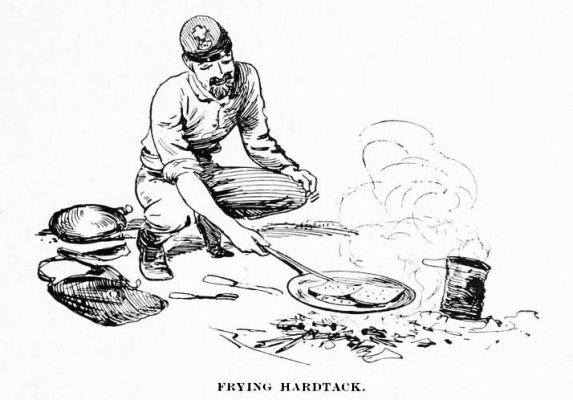
Drawings by Charles W. Reed from the 1877 memoir "Hardtack and Coffee, or the Unwritten Story of Army Life" by John D. Billings
Hardtack & Coffee - the Daily Life of a Civil War Soldier
The Civil War special exhibit at the Historical Society features items from the daily lives of Union soldiers and cavalrymen. The exhibit was prepared by Dick and Betsy Moody in conjunction with a May 2013 Civil War encampment hosted by the Historical Society for the Central School and townspeople of New Boston. Many of the items on display are modern reproductions as the originals would be too fragile for handling by our younger visitors.The American Civil War is remembered for its famous battles, including Bull Run, Shiloh, and Gettysburg. However the typical soldier was in actual combat for relatively few hours or days of this four-year war. Most of his time was spent marching or drilling, trying to stay awake on sentry duty, peeling potatoes, cleaning his weapons, mending his uniform, writing letters or reading and re-reading letters from home.
Most of the fighting took place in the south. There were no real battles in New England; the St. Alban's Raid of 1864 in Vermont was more a bank robbery than a battle. This meant that New Boston volunteers had to travel long distances by train, steamship and foot to get to the front lines. As mentioned in the New Boston Men in the War of Rebellion page, the men of the 16th Regiment New Hampshire Volunteers marched all over the Deep South, camping in fetid swamps and succumbing to mosquito-borne diseases, but never fought in a major battle.
Uniforms & Equipment
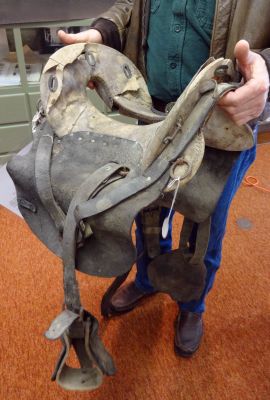 The McClellan saddle was designed just before the Civil War by George McClellan. The saddle was lightweight but sturdy and it remained in use until the U.S. Cavalry was dismounted in World War II.
George McClellan was briefly General-in-Chief of the Union Army in the early years of the Civil War. He was a cautious commander.
Exasperated by McClellan's slowness to attack, President Lincoln once remarked "If General McClellan does not want to use the army, I would like to borrow it for a time."
The McClellan saddle was designed just before the Civil War by George McClellan. The saddle was lightweight but sturdy and it remained in use until the U.S. Cavalry was dismounted in World War II.
George McClellan was briefly General-in-Chief of the Union Army in the early years of the Civil War. He was a cautious commander.
Exasperated by McClellan's slowness to attack, President Lincoln once remarked "If General McClellan does not want to use the army, I would like to borrow it for a time."
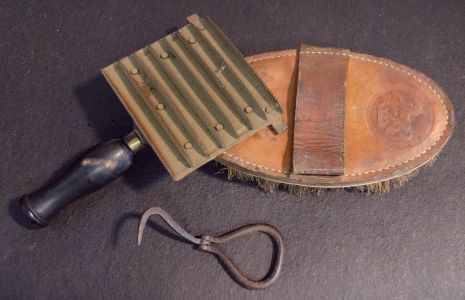 This original McClellan saddle belonged to Solomon Dodge, one of three Dodge brothers of New Boston who served in the war.
(The Dodge brothers' photographs may be seen on the New Boston Men in the War of Rebellion page.)
Solomon might have used this saddle as a mounted officer after his promotion to Lieutenant.
Dick Moody discovered the saddle underneath the barn of the Solomon Dodge farm that was later called the Christian Farm on Francestown Road.
This original McClellan saddle belonged to Solomon Dodge, one of three Dodge brothers of New Boston who served in the war.
(The Dodge brothers' photographs may be seen on the New Boston Men in the War of Rebellion page.)
Solomon might have used this saddle as a mounted officer after his promotion to Lieutenant.
Dick Moody discovered the saddle underneath the barn of the Solomon Dodge farm that was later called the Christian Farm on Francestown Road.
Lieutenant Dodge would have used a cavalry horse brush, curry comb and hoof pick to care for his mount.
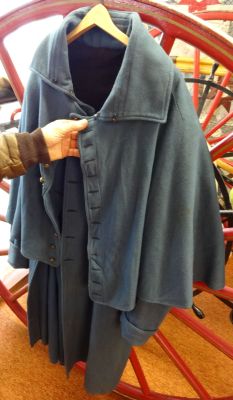 Uniforms - Wool is durable and water resistant. Wool uniforms kept the soldier warm in the winter and even warmer in the summer.
This Cavalry Great Coat had extra-long sleeves that could be unfolded to serve as mittens. The sky-blue great coat would be rolled up and carried on the saddle in front of the rider,
and was prized by Confederate soldiers when captured, as the South could not produce much wool cloth.
Uniforms - Wool is durable and water resistant. Wool uniforms kept the soldier warm in the winter and even warmer in the summer.
This Cavalry Great Coat had extra-long sleeves that could be unfolded to serve as mittens. The sky-blue great coat would be rolled up and carried on the saddle in front of the rider,
and was prized by Confederate soldiers when captured, as the South could not produce much wool cloth.
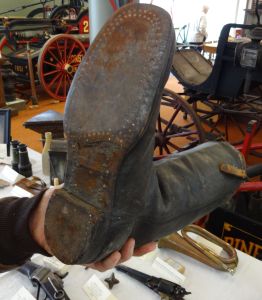 The South grew a lot of cotton, but even this could not be used to make cloth as the necessary factories were in the North or in England, from which the South was cut off by the Union blockade ships.
The South grew a lot of cotton, but even this could not be used to make cloth as the necessary factories were in the North or in England, from which the South was cut off by the Union blockade ships.
Cavalry boots were also a great prize. In fact, any shoes were valuable. If you look at battlefield photographs (the Civil War was one of the earliest wars to be documented by photography) you will notice that most of the casualties are shoeless as their footwear would be taken by the survivors.
This cavalry boot is original.
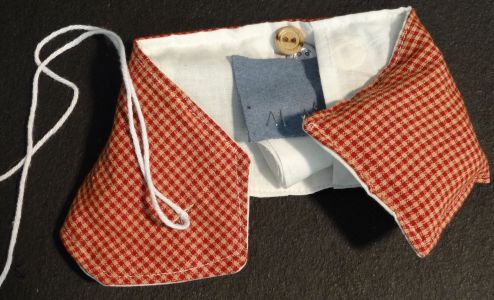
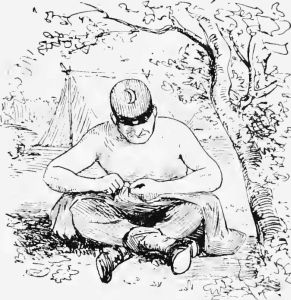
A soldier mended his uniform using a sewing kit called a "housewife".
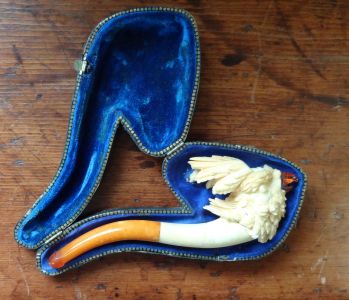
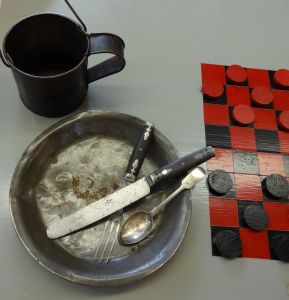
Hours were passed smoking a pipe or playing checkers.


Take-apart candlesticks and a signal lamp.
The signal lamp (above right) has a glass lens to focus the light from its whale oil flame. Kerosene from oil wells was just becoming available and was too expensive for common use. A lamp exactly like this one was found on the H. L. Hunley, a Confederate submarine that was the first submarine to sink an enemy ship.
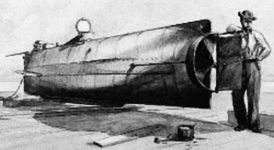 The Hunley was powered by seven crewmen turning a crank attached to its propeller.
The sub's officer might have used the lamp to read a depth gauge as he piloted the sub towards the Union ship after dark.
There is a wonderful legend about this officer, Lt. Dixon. Apparently he had a sweetheart who gave him a twenty-dollar gold coin as a good luck charm when he went off to war.
Dixon believed that this coin saved his life when it deflected a bullet during the Battle of Shiloh. However, Dixon's luck ran out during the Hunley's first and last mission,
as the submarine disappeared soon after sinking a Union ship in 1864.
You may read more at a very interesting website by the Friends of the Hunley,
which includes a photograph of Dixon's gold coin soon after it was discovered, ten years ago — the legend was true!
The Hunley was powered by seven crewmen turning a crank attached to its propeller.
The sub's officer might have used the lamp to read a depth gauge as he piloted the sub towards the Union ship after dark.
There is a wonderful legend about this officer, Lt. Dixon. Apparently he had a sweetheart who gave him a twenty-dollar gold coin as a good luck charm when he went off to war.
Dixon believed that this coin saved his life when it deflected a bullet during the Battle of Shiloh. However, Dixon's luck ran out during the Hunley's first and last mission,
as the submarine disappeared soon after sinking a Union ship in 1864.
You may read more at a very interesting website by the Friends of the Hunley,
which includes a photograph of Dixon's gold coin soon after it was discovered, ten years ago — the legend was true!
 A soldier would spend considerable time cleaning his weapon as if his life depended on it, which it did.
This Colt .44 caliber percussion cap revolver was designed to accept a clip-on shoulder stock which would provide a little more accuracy.
A soldier would spend considerable time cleaning his weapon as if his life depended on it, which it did.
This Colt .44 caliber percussion cap revolver was designed to accept a clip-on shoulder stock which would provide a little more accuracy.
A revolver could be loaded with multiple paper cartridges containing powder and bullets.
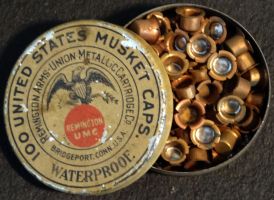 There was some risk that the first shot would cause the other chambers in the revolver to fire at the same time ("chain fire")
in which case we hope the soldier was not steadying the barrel with his other hand, or he might lose the hand.
There was some risk that the first shot would cause the other chambers in the revolver to fire at the same time ("chain fire")
in which case we hope the soldier was not steadying the barrel with his other hand, or he might lose the hand.
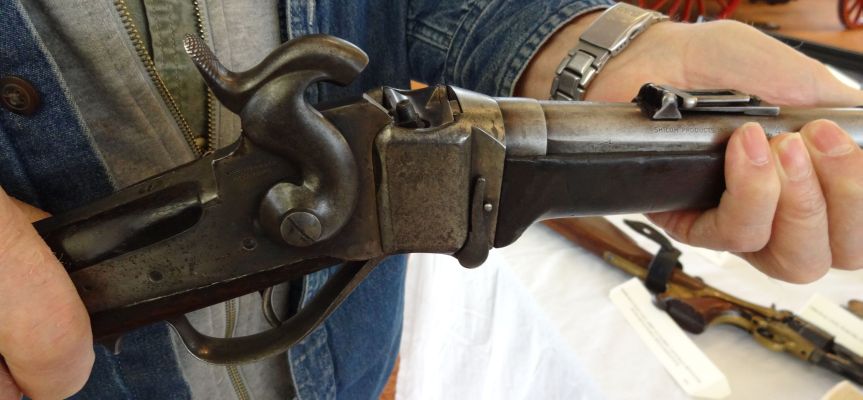
Reproduction of 1859 "New Model" Sharps Carbine
The rifle in the photo above is a .52 caliber Sharps carbine, lighter than the Sharps rifle and preferred by cavalrymen. 80,000 of these New Model 1859 Carbines were purchased by the Federal government, and the Confederacy made 5,000 copies of this design.
Hardtack & Coffee
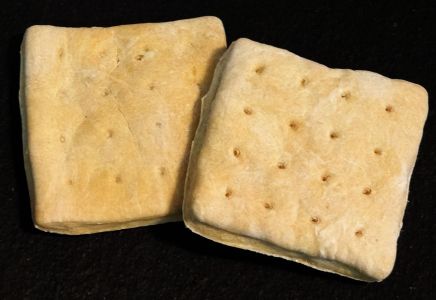

18-year-old hardtack; coffee brewing at the 2013 Civil War encampment.
Recipe for hardtack: Mix five or six parts flour with one part water. Add no sugar, no salt and no yeast! Knead the dough, roll it out to 3/8-inch thickness, cut into 3-inch squares, pierce with a fork, and bake at 300 degrees for a long time.
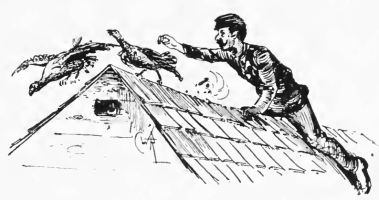 During the Civil War, soldiers naturally preferred to eat real food (not hardtack) when it was available.
However it wasn't easy to supply with fresh food many thousands of men who might be marching through enemy territory.
The Union Army quartermasters did their best with supply ships and trains and wagons. Some hungry soldiers supplemented their diet by liberating chickens and produce from the farms they passed,
but stealing was a punishable offense, at least in the early days of the war. Sometimes hardtack was the only nourishment available. It might be softened somewhat by dunking it in coffee,
or it could be fried.
During the Civil War, soldiers naturally preferred to eat real food (not hardtack) when it was available.
However it wasn't easy to supply with fresh food many thousands of men who might be marching through enemy territory.
The Union Army quartermasters did their best with supply ships and trains and wagons. Some hungry soldiers supplemented their diet by liberating chickens and produce from the farms they passed,
but stealing was a punishable offense, at least in the early days of the war. Sometimes hardtack was the only nourishment available. It might be softened somewhat by dunking it in coffee,
or it could be fried.
Hardtack wasn't always prepared under the most sanitary conditions nor was it always stored properly. Therefore it could become infested with weevils and other grubs, which might float to the surface to be skimmed off when the hardtack was dipped in coffee. Speaking of coffee...
 Coffee was a popular drink in the U.S. Army after President Jackson ordered coffee to be substituted for whiskey in the soldiers' daily rations in the 1830s.
Coffee was a healthful drink, since boiling water for coffee killed any microorganisms in the water, although germ theory was not well understood at this time. A
nd caffeine certainly energized the troops.
Coffee was a popular drink in the U.S. Army after President Jackson ordered coffee to be substituted for whiskey in the soldiers' daily rations in the 1830s.
Coffee was a healthful drink, since boiling water for coffee killed any microorganisms in the water, although germ theory was not well understood at this time. A
nd caffeine certainly energized the troops.
Sacks of coffee beans might be delivered pre-roasted or green. If green, a soldier would roast them over a campfire in a cast-iron frying pan. The roasted beans might be pulverized by the butt end of a rifle, and the grounds would be put directly in a coffee pot or tin cup. Boiling water would be poured over the grounds. In his article "Civil War soldiers made coffee America's drink" historian Fred Lynch argues that coffee's popularity today is due to Civil War soldiers acquiring a taste for the beverage and experiencing the comradeship of brewing and sharing many potsful of coffee.
Editor's note: The moment I saw the 18-year-old hardtack on display in the Historical Society and heard Dick Moody's story about how the hard crackers had to be dipped in coffee to make them chewable, I knew I had a title for this web page. I was somewhat dismayed to find that John D. Billings had already used this title 136 years earlier, in his Civil War memoir "Hardtack and Coffee, or the Unwritten Story of Army Life" published in 1877. However, I was soon lost in the pages of Billing's book, which you may read on-line. I appreciated the book's many drawings by Charles W. Reed, a few of which I reproduced on this page.
I thank Dick & Betsy Moody for their stories and the interesting display of Civil War artifacts I used for the color photographs. -Dan Rothman 2013
P.S. Here's one more hardtack story, which precedes the Civil War by a few hundred years:
The Great Fire of London which destroyed 13,000 houses and St Paul's Cathedral in 1666 began in Thomas Farriner's bakery in Pudding Lane. At that time, Farriner held the post of "Conduct of the King's Bakehouse" which meant that he had the contract to provide hardtack to the Royal Navy! (Please do keep an eye on your oven if you try the hardtack recipe included on this page.)
